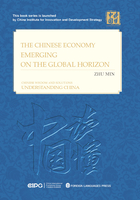
Chapter 1 China’s Economy: Soaring Dragon and Leaping Tiger
The Chinese zodiac runs in a cycle of 12 animals, each representing one year. People are linked to the zodiac animal for the year that they are born, and one’s zodiac animal is said to reveal character traits or aspects of their personality. Among the zodiac animals, the Tiger and the Dragon are known for their extraordinary strength, capabilities, flexibility and creativity. In this sense, the Chinese idiom “soaring dragon and leaping tiger” is a most fitting description for China’s economic reform and opening up. Over the past four decades, the Chinese economy has advanced by leaps and bounds. In 1978, China’s GDP was a mere RMB367.87 billion, equivalent to USD210 billion, ranking 9th in the world, after the US, Japan, the Soviet Union, the Federal Republic of Germany, France, the UK, Italy, and Canada. Its per capita GDP was a paltry USD156, far below the global average of over USD 2, 000 dollars. In 2016, China’s GDP totaled USD11.2 trillion, attaining for China the status as the world’s second-largest economy, and its per capita GDP topped USD8, 000, approximating the global average.1
This miracle began with China’s rural reforms in 1978. Despite its immense landmass, China had very limited arable land, and productivity among its huge population remained low. In 1978, it was this “life-and-death” agreement inked by a group of farmers in the tiny impoverished village of Xiaogang, in Anhui Province, that ushered in the nation’s rural reforms. Soon, the People’s Communes were abolished and a household contract responsibility system was instituted, followed by the rise of township and village enterprises (TVEs) and the influx of farmers to the cities. However, the household contract system was not effective in achieving economies of scale or large-scale socialized production, and land transfers remained severely restricted. Thus, the double-tier household contract responsibility system was replaced by the current “three-rights separation” system, in which ownership rights, contract rights and management rights are separated. Collective ownership of land has ensured social equity in law, and the separation of the three types of rights has led to modernized agricultural production. The growth of TVEs, the increasing number of migrant workers in cities, and the coordinated development of urban and rural areas have helped absorb much of the surplus rural labor.
Prior to reform, China’s entire industrial system was centrally planned, with all enterprises owned by the state and heavy industries given priority. Hence, the history of China’s industrial development is essentially one of reform of state-owned enterprises, of the steady rise of state-owned, privately held and foreign-invested enterprises, and of the gradual balancing of industry, agriculture and services.
Shortly after rural reforms kicked off in 1978, reform of state-owned enterprises followed. Economic reforms surged during the 1980s on the success of rural reforms, and gained an extra spurt of momentum during the 1990s from the launch of the socialist market system. Afterward, with the establishment of government agencies for managing state-owned assets, China entered a period of reform with clear goals, elaborate plans and incremental measures. The 1980s also saw the emergence of private enterprises. Many well-known enterprises, which had grown from humble origins as TVEs, absorbed large numbers of surplus laborers from reformed stated-owned enterprises and rural areas. Foreign-invested enterprises also emerged in coastal Guangdong, to capitalize on the growth of special economic zones. Originally focused on the processing trade, they eventually became the main force in China’s manufacturing sector. The success of the Chinese manufacturing sector in quickly expanding their operations and penetrating the global marketplace can be attributed to one of the main comparative advantages of the Chinese economy – low labor costs. As this demographic dividend dwindles, the Chinese government has put forward the concept of “innovation-driven development”, with all enterprise reforms, industrial development and foreign trade centered on innovation.
In China, the development of foreign trade has been closely associated with the reform of the trade system. Reform is largely a process in which state regulation has been gradually relaxed and brought into closer line with international practices. The format of foreign trade has evolved in the process. Prior to 1978, the processing trade was virtually non-existent in China. In 1980, with the establishment of special economic zones and the inflow of foreign investment, the processing trade became the main form of China’s foreign trade. In 2001, China’s accession to the WTO ushered in a golden era for foreign trade. In 2009, with the growth of indigenous industries, the processing trade as a share of trade began to decline, surpassed by general trade in 2011. Since the 2008 financial crisis, the trade structure has been steadily upgraded. As the Doha round of trade negotiations among WTO members stalls, China has stepped up its efforts to build free trade zones. While implementing the 16 free trade agreements already in place, China will push forward negotiations on the establishment of the Asia-Pacific Free Trade Zone and the Regional Comprehensive Economic Partnership, with the aim of creating a global network of free trade zones.
This chapter will explore the reform and development of China’s rural economy, industrial economy, enterprises and foreign trade since 1978.